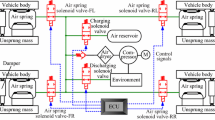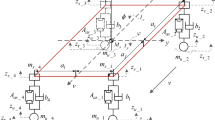Abstract
The current research of air suspension mainly focuses on the characteristics and design of the air spring. In fact, electronically controlled air suspension (ECAS) has excellent performance in flexible height adjustment during different driving conditions. However, the nonlinearity of the ride height adjusting system and the uneven distribution of payload affect the control accuracy of ride height and the body attitude. Firstly, the three-point measurement system of three height sensors is used to establish the mathematical model of the ride height adjusting system. The decentralized control of ride height and the centralized control of body attitude are presented to design the ride height control system for ECAS. The exact feedback linearization method is adopted for the nonlinear mathematical model of the ride height system. Secondly, according to the hierarchical control theory, the variable structure control (VSC) technique is used to design a controller that is able to adjust the ride height for the quarter-vehicle anywhere, and each quarter-vehicle height control system is independent. Meanwhile, the three-point height signals obtained by three height sensors are tracked to calculate the body pitch and roll attitude over time, and then by calculating the deviation of pitch and roll and its rates, the height control correction is reassigned based on the fuzzy algorithm. Finally, to verify the effectiveness and performance of the proposed combined control strategy, a validating test of ride height control system with and without road disturbance is carried out. Testing results show that the height adjusting time of both lifting and lowering is over 5 s, and the pitch angle and the roll angle of body attitude are less than 0.15°. This research proposes a hierarchical control method that can guarantee the attitude stability, as well as satisfy the ride height tracking system.
Similar content being viewed by others
References
YOUN J, PARK I, SUNWOO M. Heuristic resource allocation and scheduling method for distributed automotive control systems[J]. International Journal of Automotive Technology, 2013, 14(4): 611–624.
LI Liang, SONG Jian, He Lin, et al. Life prediction based on transient dynamics analysis of van semi-trailer with air suspension system[J]. Chinese Journal of Mechanical Engineering, 2011, 24(3): 372–379.
TANG Chuanyin, ZHANG Yimin, ZHAO Guangyao, et al. Annoyance rate evaluation method on ride comfort of vehicle suspension system[J]. Chinese Journal of Mechanical Engineering, 2014, 27(2): 296–303.
CHEN Yikai, HE Jie, KING M, et al. Effect of driving conditions and suspension parameters on dynamic load-sharing of longitudinal-connected air suspensions[J]. Science China Technological Sciences, 2013, 56(3): 666–676.
KAT C J, SCHALK ELS P. Interlinked air spring model[J]. Mathematical and Computer Modeling of Dynamics Systems, 2009, 15(4): 353–370.
ALAN F, LAURA M, STEFANO A, STEFANO B. Mathematical modelling of the secondary airspring suspension in railway vehicles and its effect on safety and ride comfort[J]. Vehicle System Dynamics, 2010, 48(S1): 429–449.
ALONSO A, GIMENEZ J G, NIETO J, et al. Air suspension characterization and effectiveness of a variable area orifice[J]. Vehicle System Dynamics, 2010, 48(S1): 271–286.
BURTON A W, TRUSCOT A J, WELLSTEAD P E. Analysis, modeling and control of an advanced automotive self-levelling suspension system[J]. IEE Proceedings - Control Theory and Applications, 1995, 142(2): 129–139.
BEMPORAD A, MORARI M. Verification of hybrid systems via mathematical programming [J]. Hybrid Systems: Computation and Control, 1999, 1569: 31–45.
CHEN Zhilin, JIN Dafeng, MA Guoxin. Simulation of variable structure control strategy in combination with PID for vehicle body height[J]. Journal of Tsinghua University (Science and Technology), 1999, 39(8): 72–75. (in Chinese)
YU Weibo, ZHANG Lizhu, LIN Nan. Study of the fuzzy control of air suspension of vehicle height system[J]. Instrumentation Customer, 2006, 13(2): 6–8. (in Chinese)
SONG Yu. Study on ride height PID control technology of air suspension vehicle[J]. Journal of Hubei Automotive Industries Institute, 2007, 21(2): 1–4. (in Chinese)
YANG Qiyao. Research on matching and inflation/deflating of suspension system in ECAS-Bus[D]. Zhenjiang: Jiangsu University, 2008. (in Chinese)
XU Xing, SUN Liqin, CUI Zhen, et al. Stability analysis of electronically controlled air suspension ride height system based on center manifold method[J]. Journal of Computational and Theoretical Nanoscience, 2014, 11(2): 385–390.
XU Xing, CHEN Zhaozhang, LI Zhongxing. Investigation on modeling and control of body height adjustment for bus with electrically controlled air suspension[J]. Automobile Technology, 2009 (11): 42–46. (in Chinese)
XU Xing, CHEN Zhaozhang, QUAN Li. Real-time tracking of ride height for bus with electronically controlled air suspension[J]. Journal of Mechanical Engineering, 2011, 47(2): 136–141. (in Chinese)
FENG Yuanyuan, DU Qungui. Investigation on body height adjustment for semi-trailer with electrically controlled air suspension and design of fuzzy/PWM controller[J]. Science Technology and Engineering, 2010, 32(10): 7974–7979, 7992. (in Chinese)
KIM H, LEE H. Height and leveling control of automotive air suspension system using sliding mode approach[J]. IEEE Transactions on Vehicular Technology, 2011, 60(5): 2027–2041.
KIM H, LEE H. Fault-tolerant control algorithm for a four-corner closed-loop air suspension system[J]. IEEE Transaction on Industrial Electronics, 2011, 58(10): 4866–4879.
KIM H, LEE H. Model-based fault-tolerant control for an automotive air suspension control system[J]. Proceedings of the Institution of Mechanical Engineers Part D-Journal of Automobile Engineering, 2011, 225(D11): 1462–1480.
UTKIN V I, CHANG Chaochi, WILFRID P, et al. Sliding mode control on electro-mechanical systems[J]. Mathematics Problem in Engineering, 2002, 8(4–5): 451–473.
BAO Wenning, CHEN Liping, ZHANG Yunqi, et al. Fuzzy adaptive sliding mode controller for an air spring active suspension[J]. International Journal of Automotive Technology, 2012, 13(7): 1057–1065.
Author information
Authors and Affiliations
Corresponding author
Additional information
Supported by National Natural Science Foundation of China (Grant No. 51105177), Jiangsu Provincial Natural Science Foundation of China (Grant No. BK20131255), Research Fund for the Doctoral Program of Higher Education of China (Grant No. 20113227120015), Qing Lan Project of Jiangsu Province of China, Scientific Research Foundation for Advanced Talents, Jiangsu University, China (Grant No. 11JDG047), and Hunan Provincial Natural Science Foundation of China (Grant No. 12JJ6036)
XU Xing, born in 1979, is currently a lecturer and a master candidate supervisor at School of Automotive and Traffic Engineering, Jiangsu University, China. He received his PhD degree from Jiangsu University, China, in 2010. His research interests include vehicle system dynamics and control.
ZHOU Kongkang, born in 1938, is currently a professor and a PhD candidate supervisor at School of Automotive and Traffic Engineering, Jiangsu University China. He received his master degree from Jiangsu University, China, in 1980. His research interests include vehicle dynamic performance simulation and control.
ZOU Nannan, born in 1990, is currently a master candidate at School of Automotive and Traffic Engineering, Jiangsu University China. His research interests include vehicle system modeling and fault-tolerant control.
JIANG Hong, born in 1963, is currently a professor and a master candidate supervisor at School of Mechanical Engineering, Jiangsu University, China. She received her master degree from Jiangsu University, China, in 1992. Her research interests include vehicle dynamics simulation and system design.
CUI Xiaoli, born in 1962, is currently a professor at School of Mechanical Engineering, Hunan Institute of Technology, China. She received her PhD degree from Zhongnan University, China, in 2011. Her research interests include vehicle CAE and integration.
Rights and permissions
About this article
Cite this article
Xu, X., Zhou, K., Zou, N. et al. Hierarchical control of ride height system for electronically controlled air suspension based on variable structure and fuzzy control theory. Chin. J. Mech. Eng. 28, 945–953 (2015). https://doi.org/10.3901/CJME.2015.0615.081
Received:
Revised:
Accepted:
Published:
Issue Date:
DOI: https://doi.org/10.3901/CJME.2015.0615.081




